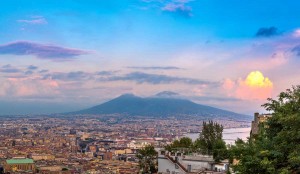
©Bigstock.com/bloodua
Total area of 1,700 ha, 27 centuries’ worth of architectural and cultural history, breathtaking religious and secular sights as far as the eye can see – the historic centre of Naples is both the largest historic centre in all of Europe and one of the most beautiful places in the entire world. Palpable history ranging from Greek settlements to modern influences, countless churches and palaces, and a hint of year-round Christmas make Campania’s capital one of Italy’s main tourist attractions and, additionally, a genuine highlight for your next holiday. You’re probably wondering what there is to discover and explore in the Centro Storico of Naples, which was declared UNESCO World Heritage Site in 1995. We’ll gladly share our best travel suggestions with you! First, however, let’s dive into the long and illustrious history of this metropolis.
How Naples became Naples
Sure, we could write entire books on Naples’ fascinating history. You’ll find an abundance of such written works in shops and libraries. Thus, we only give you a brief overview of how Naples actually became Naples. We start our journey in 700 BC, when the Greeks established the settlement Parthenope, named after a siren, on today’s city grounds. Another settlement was established northeast of Parthenope approx. 200 years later. It quickly grew even bigger and was named Neapolis (“new city”). Encompassing the area of today’s Centro Storico, it was eventually conquered by the Roman Empire. You still can see remnants of Naples’ early settlements, such as ruins of the city walls, the acropolis, of antique houses and thermae.

©Bigstock.com/Ibryan
The Migration Period eventually resulted in the Duchy of Naples, after which the Normans, the Hohenstaufen, the Anjou, the Aragonese and the Habsburg ruled over the course of the following centuries. The Spanish viceroys took care of the city’s expansion and reconstructed the historic centre. Uprisings established the short-lived Republic of Naples. The city flourished again during the reign of the Bourbons before, one more time, seeing many different rulers. The Republic of Italy initially brought some much-needed stability in the late 19th century, yet also caused severe social and structural issues leading to mass emigration to the north, which still causes problems for Naples’ ailing economy. However, the stunning beauty of the historic centre remains unblemished.
The centre
What is it that makes the historic centre of Naples an important UNESCO World Heritage Site? There are many reasons for this status, one of which must be the sheer size of the city centre. Its art and architecture reflect the influence of countless cultures and rulers, all of them having left their unique mark on the city. You can even still marvel at documents of pre-Christian settlement in the palaces, churches and museums. Knowing this, you probably won’t be surprised that there is a high density of sights in the historic centre with one highlight after the other. Delimitated by Via Alessandro Poerio, Piazza Cavour and Via Carbonara in the north, Corso Umberto I. in the southeast, and Via Monteoliveto and Via Toledo in the west, the city centre features yet another scenic highlight in the bay of the Gulf of Naples. If you have a bit more time at hand, you absolutely should add a walk through the port or a brief trip to the one of the gulf islands to your travel plans.
You’d like to know which of the countless highlights are must-see? Funny you should ask, we might just have a few suggestions in store for you.
Naples Cathedral
It certainly deserves its own paragraph: San Gennaro, dedicated to Januarius, the city’s patron saint, is among the most beautiful and significant religious buildings in all of Italy. Having been commissioned in the 13th century by King Charles I of Anjou and eventually finished under King Robert of Anjou in the early 14th century, it was constructed on the remnants of two basilicas, which themselves had been built on Roman and Greek foundations. Glorious paintings and mosaics, chapels and frescoes hide behind the monumental façade. Believers from all over the world visit the cathedral due to a vial containing the blood of Januarius, which is shown every first Saturday in May and on September 19th. If the dried blood liquefies – this phenomenon is also known as the “Miracle of the Blood of Januarius” –, it is seen as a good omen for the weeks and months to follow.
Churches and chapels
Hundreds of churches, numerous monasteries and chapels line the streets of Naples, a lot of which can be found in its historic centre. Beyond the cathedral, the monastery and church complex of Santa Chiara is regarded as the city’s most important centre of religion. The Gothic masterpiece, which was completely destroyed during World War II and re-built thanks to public donations, houses a museum, the picturesque cloister Chiostro delle Maioliche and the tombs of numerous kings and aristocrats. The rather inconspicuous Jesuit church Gesù Nuovo, located next to the charming Santa Lucia, impresses with grand baroque art behind its façade. You might also want to stop by Cappella Sansevero. The small baroque church is particularly known for its many impressive marble statues.
Palaces and fortresses
The palaces and villas of Naples also impress due to their sheer strength in number, even surpassing that of the city’s religious buildings. Palazzo Reale, constructed in the first half of the 16th century during the reign of the Spanish viceroy Pedro Álvarez de Toledo, used to house the (royal) residence of Bourbon-Sicily and the House of Savoy. Castel Nuovo and Castel dell’Ovo, together with Castel Sant’Elmo located on the city hill outside the historic centre, form the fortress trifecta of Naples. The accessible castles are now home to museums, restaurants and event locations.
The street of nativity scenes
Did you know that it’s Christmas all year in Naples? Via San Gregorio Armeno is also known as the “street of nativity scenes”, as it is lined with workshops mostly dedicated to building the world-famous Neapolitan nativity scenes. Traditional biblical characters aside, you also come across classic city life scenes from earlier centuries – something that is best experienced during a guided tour through the workshops or in Advent time while roaming through the festively decorated street with its Christmas market.
So many sights, palpable history and festive tradition at once – only in Naples! Accompanied by small souvenir shops, friendly cafés and amazing cuisine beyond compare, your stay in the capital of Campania will certainly turn out to be a delightful experience. Whether you’re planning a day trip or a full city holiday including trips to the surrounding villages and onto picturesque islands – see for yourself what makes Naples so special and let the many other enticing travel suggestions by ZAINOO inspire you to visit Italy!